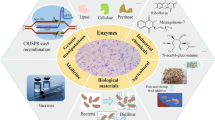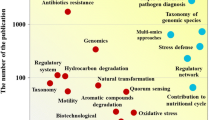Abstract
The aim of this work was to test the hypothesis that a putative multisensory hybrid histidine kinase—response regulator (HSHK–RR) and FlhB (a component of the type 3 secretion apparatus located in the basal body of Fla) encoded by Azospirillum baldaniorum Sp245 by adjacent chromosomal genes, are involved in mechanosensing and mechanotransduction. We used Sp245 strains and its Fla–Laf– mutant Sp245.1063 (flhB1::Omegon-Km). To construct A. baldaniorum derivatives with an increased dose of CDS AZOBR_150176 (HSHK–RR), this sequence of strain Sp245 was cloned in the pRK415 expression vector. The resulting structure was transferred to Sp245 and Sp245.1063 bacteria. Cell morphology was studied using phase-contrast and transmission electron microscopy. The relative amount of biofilm biomass was determined by staining the bacteria with a crystal violet. Derivatives of the Sp245 strain and its immotile mutant Sp245.1063 (flhB1::Omegon-Km) with an increased dose of HSHK–RR were obtained. It was found that a mutation in the gene encoding the FlhB protein or an increase in the copy number of the gene encoding HSHK–RR affect the motility and ultrastructure of cells, the dynamics of changes in cell size and the flagellation when changing the mechanical properties of the medium. Primary data have been obtained indicating that the cell membrane-associated FlhB proteins and HSHK–RR are involved in the perception of changes in the mechanical properties of the medium and in the transmission of the corresponding mechanical signals in A. baldaniorum cells.
Similar content being viewed by others
REFERENCES
Dufrêne, Y.F. and Persat, A., Mechanomicrobiology: How bacteria sense and respond to forces, Nat. Rev. Microbiol., 2020, vol. 18, no. 4, pp. 227–240. https://doi.org/10.1038/s41579-019-0314-2
Fajardo-Cavazos, P. and Nicholson, W.L., Mechanotransduction in prokaryotes: A possible mechanism of spaceflight adaptation, Life, 2021, vol. 11, no. 1, p. 33. https://doi.org/10.3390/life11010033
Fibach-Paldi, S., Burdman, S., and Okon, Y., Key physiological properties contributing to rhizosphere adaptation and plant growth promoting abilities of Azospirillum brasilense, FEMS Microbiol. Lett., 2012, vol. 326, no. 2, pp. 99–108. https://doi.org/10.1111/j.1574-6968.2011.02407.x
Dos Santos Ferreira, N., Hayashi Sant’ Anna, F., Massena Reis, V., Ambrosini, A., Gazolla Volpiano, C., Rothballer, M., et al., Genome-based reclassification of Azospirillum brasilense Sp245 as the type strain of Azospirillum baldaniorum sp. nov., Int. J. Syst. Evol. Microbiol., 2020, vol. 70, no. 12, pp. 6203–6212. https://doi.org/10.1099/ijsem.0.004517
Moens, S., Michiels, K., Keijers, V., Van Leuven, F., and Vanderleyden, J., Cloning, sequencing and phenotypic analysis of laf1, encoding flagellin of the lateral flagella of Azospirillum brasilense Sp7, J. Bacteriol., 1995, vol. 177, no. 19, pp. 5419–5426. https://doi.org/10.1128/jb.177.19.5419-5426.1995
Shelud’ko, A.V., Filip’echeva, Y.A., Telesheva, E.M., Yevstigneeva, S.S., Petrova, L.P., and Katsy, E.I., Polar flagellum of the alphaproteobacterium Azospirillum brasilense Sp245 plays a role in biofilm biomass accumulation and in biofilm maintenance under stationary and dynamic conditions, World J. Microbiol. Biotechnol., 2019, vol. 35, no. 2, p. 19. https://doi.org/10.1007/s11274-019-2594-0
Shelud’ko, A.V., Filip’echeva, Yu.A., Shumilova, E.M., Khlebtsov, B.N., Burov, A.M., Petrova, L.P., and Katsy, E.I., Changes in biofilm formation in the nonflagellated flhB1 mutant of Azospirillum brasilense Sp245, Microbiology (Moscow), 2015, vol. 84, no. 2, pp. 144–151. https://doi.org/10.1134/S0026261715010129
Filip’echeva, Yu., Shelud’ko, A., Prilipov, A., Telesheva, E., Mokeev, D., Burov, A., et al., Chromosomal flhB1 gene of the alphaproteobacterium Azospirillum brasilense Sp245 is essential for correct assembly of both constitutive polar flagellum and inducible lateral flagella, Folia Microbiol., 2018, vol. 63, no. 2, pp. 147–153. https://doi.org/10.1007/s12223-017-0543-6
Baldani, V.L.D., Baldani, J.I., and Döbereiner, J., Effects of Azospirillum inoculation on root infection and nitrogen incorporation in wheat, Can. J. Microbiol., 1983, vol. 29, no. 8, pp. 924–929. https://doi.org/10.1139/m83-148
Figurski, D.H. and Helinski, D.R., Replication of an origin-containing derivative of plasmid RK2 dependent on a plasmid function provided in trans, Proc. Natl. Acad. Sci. U. S. A., 1979, vol. 76, no. 4, pp. 1648–1652. https://doi.org/10.1073/pnas.76.4.1648
Keen, N.T., Tamaki, S., Kobayashi, D., and Trollinger, D., Improved broad-host-range plasmids for DNA cloning in Gram-negative bacteria, Gene, 1988, vol. 70, no. 1, pp. 191–197. https://doi.org/10.1016/0378-1119(88)90117-5
Döbereiner, J. and Day, J.M., Associative symbiosis in tropical grass: Characterization of microorganisms and dinitrogen fixing sites, Proc. 1st International Symposium on Nitrogen Fixation, Pullman, WA, 1974, Newton, W.E. and Nyman, C.J., Eds., Washington, DC: Washington State Univ. Press, 1976, pp. 518–538.
Molecular Cloning: A Laboratory Manual, Sambrook, J., Fritsch, E.F., and Maniatis, T., Eds., New York: Cold Spring Harbor Laboratory Press, 1989.
O’Toole, G.A. and Kolter, R., Initiation of biofilm formation in Pseudomonas fluorescens WCS365 proceeds via multiple, convergent signalling pathways: A genetic analysis, Mol. Microbiol., 1998, vol. 28, no. 3, pp. 449–461. https://doi.org/10.1046/j.1365-2958.1998.00797.x
ACKNOWLEDGMENTS
The authors thank the Simbioz Center for the Collective Use of Research Equipment in the Field of Physical-Chemical Biology and Nanobiotechnology, Institute of Biochemistry and Physiology of Plants and Microorganisms, Russian Academy of Sciences for kindly providing access to the Leica DM6000 B and Libra 120 equipment.
Funding
This study was partially supported by the Russian Foundation for Basic Research, project no. 20-04-00006_а.
Author information
Authors and Affiliations
Corresponding author
Ethics declarations
Conflict of interest. The authors declare that they have no conflict of interest.
This article does not contain any studies involving animals or human beings performed by any of the authors.
Additional information
Translated by M. Novikova
About this article
Cite this article
Evstigneeva, S.S., Mokeev, D.I., Petrova, L.P. et al. Genetic Aspects of Mechanosensitivity in the Alphaproteobacteria Azospirillum baldaniorum with Mixed Flagellation. Mol. Genet. Microbiol. Virol. 37, 86–90 (2022). https://doi.org/10.3103/S0891416822020045
Received:
Revised:
Accepted:
Published:
Issue Date:
DOI: https://doi.org/10.3103/S0891416822020045




